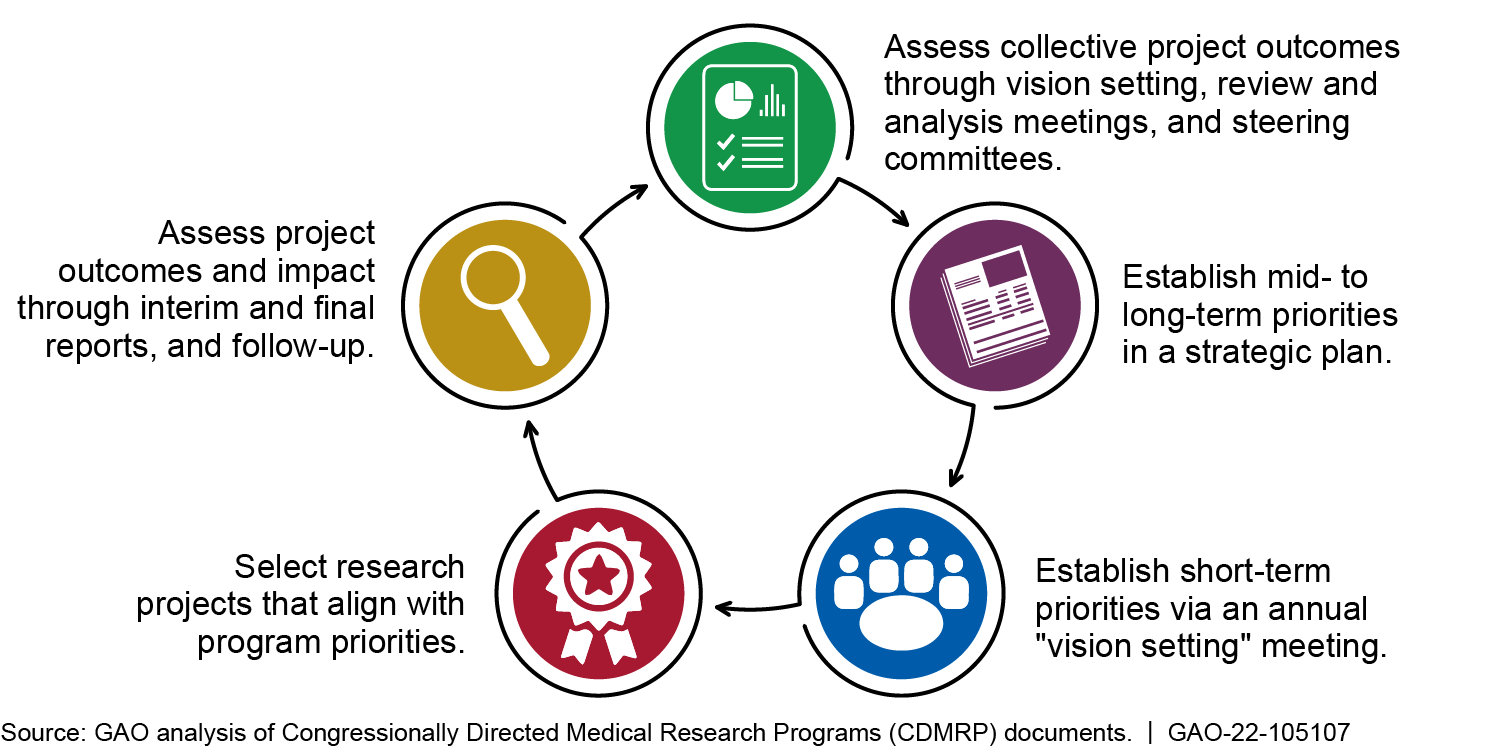Biomedical Research: Observations on DOD's Management of Congressionally Directed Medical Research Programs
Fast Facts
DOD awards funds to biomedical researchers for projects on topics identified by Congress. The projects contribute to the development of new drugs, vaccines, and medical devices.
DOD uses a cyclical, routine process to prioritize investments from these funds. In FYs 2015-19, it distributed nearly 100% of its $4.46 billion in funding.
DOD coordinates with the Department of Veterans Affairs and the National Institutes of Health, which also sponsor research. While we found a few DOD projects were similar in topic and methods to VA and NIH projects, their use of a shared database has helped identify and prevent overlap and duplication.

Highlights
What GAO Found
The Department of Defense (DOD) awards funds from Congressionally Directed Medical Research Programs (CDMRP) appropriations to researchers for projects that focus on advancements in military medicine and public health benefits for areas such as cancers and substance abuse. A typical award ranges from less than $100,000 for a project with a new focus to millions of dollars for a clinical trial. Based on DOD data, for fiscal years 2015 through 2019, DOD obligated—committed government funds—nearly 100 percent of approximately $4.46 billion in available CDMRP appropriations. About 1.3 percent ($59.252 million) was unobligated for the period.
DOD uses a cyclical, routine process to prioritize and assess investments from CDMRP appropriations (see figure).
Department of Defense Cyclical, Routine Process for Prioritizing and Assessing CDMRP Investments

For example, each year following receipt of appropriations, DOD convenes a panel of experts for each program to help CDMRP staff agree on a strategy and priorities for the mid- and long-term and the upcoming year. These panels also review research applications and recommend ones to award funds based on their alignment with program priorities and expected impact, according to DOD officials. GAO's analysis of documents for 25 selected projects and the respective research programs found that each applicant clearly stated the relationship between the project and one or more program priorities.
The National Institutes of Health (NIH) and the Department of Veterans Affairs (VA) are significant federal sponsors of biomedical research. DOD coordinates with NIH and VA for CDMRP planning and project selection throughout the process shown in the above figure. For program planning during annual "vision setting," panels discuss research sponsored by other organizations and help ensure CDMRP investments are complementary. The panels generally include officials from NIH, VA, or both.
CDMRP also coordinates with NIH and VA by leveraging shared data to identify and mitigate project overlap. In response to a 2012 GAO report, DOD and NIH implemented an electronic interface between their research administration systems through the NIH Query View Report system, which includes VA data. CDMRP's full implementation of the system began in fiscal year 2019, when staff used it during application reviews to identify potential overlap with NIH and VA research. According to DOD officials, using shared data has helped them identify overlap and duplication in research projects, which led them to take mitigation steps and avoid cost for the federal government. In comparing 25 selected CDMRP projects with NIH- and VA- projects funded during the same period, GAO found that some projects were similar in topic and methods. GAO identified two projects (one from CDMRP and one from NIH) that contained verifiable overlap, which program managers had identified and addressed. In this instance, CDMRP and the researcher reduced the project's scope and budget. Through these and other coordination activities that are consistent with leading practices for collaboration, CDMRP is able to avoid and mitigate overlap and duplication of biomedical research efforts across DOD, NIH, and VA.
Why GAO Did This Study
DOD is among the United States' largest federal sponsors of biomedical research. For fiscal year 2021, DOD's appropriations included about $1.5 billion for 36 research programs known collectively as CDMRP. This represents a significant increase from CDMRP's initial appropriation in 1992 of $210 million for a breast cancer program.
The Joint Explanatory Statement accompanying the Consolidated Appropriations Act, 2021 includes a provision for GAO to review DOD’s CDMRP. This report provides information on CDMRP’s (1) execution of annual appropriations; (2) efforts to prioritize and assess biomedical research programs and investments; and (3) coordination of biomedical research with NIH and VA.
To address these objectives, GAO:
- analyzed DOD budget data for each CDMRP program for fiscal years 2015 through 2019 appropriation years;
- reviewed planning documents and research outcomes for a nongeneralizable sample of five programs for fiscal years 2018 through 2020 selected on the basis of size, subject, and research organizations awarded;
- analyzed records for 25 projects selected randomly from each selected program;
- reviewed reports and memorandums on research partnerships and collaboration;
- compared CDMRP research abstracts for selected projects with abstracts for NIH- and VA-funded projects to identify similarities and understand coordination steps; and
- interviewed officials from DOD, NIH, and VA.
For more information, contact Elizabeth Field at (202) 512-2775 or FieldE1@gao.gov.
